Waveguide Junction
Waveguide junctions enable power to be split, extracted or combined - there are various types including E-Type, H-Type, Magic T, Hybrid Ring.
Home » Antennas & Propagation » this page
Waveguide Tutorial Includes:
Waveguide basics
Waveguide modes
Waveguide impedance & matching
Waveguide cut-off-frequency
Waveguide flanges
Waveguide junctions
Waveguide bends
Flexible waveguide
Waveguide types & sizes
Waveguide junctions are used to enable power in a waveguide to be split, combined or for some extracted.
There are a number of different types of waveguide junction that can be used, each type having different properties - the different types of waveguide junction affect the energy contained within the waveguide in different ways. The common types of waveguide junction include the E-Type, H-Type, Magic T and Hybrid Ring junctions.
The different forms of waveguide junction have different properties and this means that they are applicable for different applications. Having an understanding of their different properties enables the correct type to be chosen.
Waveguide junction types
The main types of waveguide junction are listed below:
- E-Type T Junction: The E-type waveguide junction gains its name because the top of the "T" extends from the main waveguide in the same plane as the electric field in the waveguide.
- H-type T Junction: The H-type waveguide junction gains its name because top of the "T" in the T junction is parallel to the plane of the magnetic field, H lines in the waveguide.
- Magic T Junction: The magic T waveguide junction is effectively a combination of the E-type and H-type waveguide junctions.
- Hybrid Ring Waveguide Junction: This is another form of waveguide junction that is more complicated than either the basic E-type or H-type waveguide junction. It is widely used within radar system as a form of duplexer.
E-type waveguide junction
It is called an E-type T junction because the junction arm, i.e. the top of the "T" extends from the main waveguide in the same direction as the E field. It is characterized by the fact that the outputs of this form of waveguide junction are 180° out of phase with each other.

The basic construction of the waveguide junction shows the three port waveguide device. Although it may be assumed that the input is the single port and the two outputs are those on the top section of the "T", actually any port can be used as the input, the other two being outputs.
To see how the waveguide junction operates, and how the 180° phase shift occurs, it is necessary to look at the electric field. The magnetic field is omitted from the diagram for simplicity.
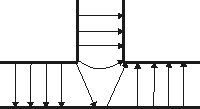
It can be seen from the electric field that when it approaches the T junction itself, the electric field lines become distorted and bend. They split so that the "positive" end of the line remains with the top side of the right hand section in the diagram, but the "negative" end of the field lines remain with the top side of the left hand section. In this way the signals appearing at either section of the "T" are out of phase.
These phase relationships are preserved if signals enter from either of the other ports.
H-type waveguide junction
This type of waveguide junction is called an H-type T junction because the long axis of the main top of the "T" arm is parallel to the plane of the magnetic lines of force in the waveguide. It is characterized by the fact that the two outputs from the top of the "T" section in the waveguide are in phase with each other.
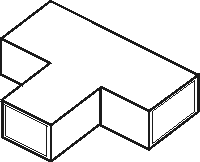
To see how the waveguide junction operates, the diagram below shows the electric field lines. Like the previous diagram, only the electric field lines are shown. The electric field lines are shown using the traditional notation - a cross indicates a line coming out of the screen, whereas a dot indicates an electric field line going into the screen.
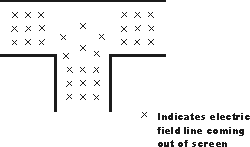
It can be seen from the diagram that the signals at all ports are in phase. Although it is easiest to consider signals entering from the lower section of the "T", any port can actually be used - the phase relationships are preserved whatever entry port is used.
Magic T hybrid waveguide junction
The magic-T is a combination of the H-type and E-type T junctions. The most common application of this type of junction is as the mixer section for microwave radar receivers.
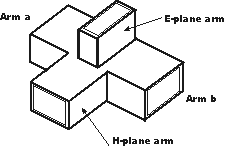
The diagram above depicts a simplified version of the Magic T waveguide junction with its four ports.
To look at the operation of the Magic T waveguide junction, take the example of when a signal is applied into the "E plane" arm. It will divide into two out of phase components as it passes into the leg consisting of the "a" and "b" arms. However no signal will enter the "E plane" arm as a result of the fact that a zero potential exists there - this occurs because of the conditions needed to create the signals in the "a" and "b" arms. In this way, when a signal is applied to the H plane arm, no signal appears at the "E plane" arm and the two signals appearing at the "a" and "b" arms are 180° out of phase with each other.
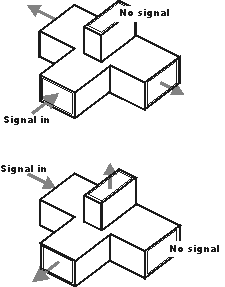
When a signal enters the "a" or "b" arm of the magic t waveguide junction, then a signal appears at the E and H plane ports but not at the other "b" or "a" arm as shown.
One of the disadvantages of the Magic-T waveguide junction are that reflections arise from the impedance mismatches that naturally occur within it. These reflections not only give rise to power loss, but at the voltage peak points they can give rise to arcing when used with high power transmitters. The reflections can be reduced by using matching techniques. Normally posts or screws are used within the E-plane and H-plane ports. These solutions improve the impedance matches and hence the reflections, but there is a power handling capacity penalty.
Hybrid ring waveguide junction
This form of waveguide junction overcomes the power limitation of the magic-T waveguide junction.
A hybrid ring waveguide junction is a further development of the magic T. It is constructed from a circular ring of rectangular waveguide - a bit like an annulus. The ports are then joined to the annulus at the required points. Again, if signal enters one port, it does not appear at all the others. The junction is able to provide high levels of isolation, although the exact values should be checked in the datasheets for the particular junction being considered.
The hybrid ring is used primarily in high-power radar and communications systems where it acts as a duplexer - allowing the same antenna to be used for transmit and receive functions.
During the transmit period, the junction couples microwave energy from the transmitter to the antenna while blocking energy from the receiver input. Then as the receive cycle starts, the hybrid ring waveguide junction couples energy from the antenna to the receiver. During this period it prevents energy from reaching the transmitter.
Waveguide junctions are an essential type of configuration that enable power to be split and combined in a variety of ways. They considerably simplify many systems, and although many are quite expensive, they provide a high performance method of achieving their function.
 Written by Ian Poole .
Written by Ian Poole .
Experienced electronics engineer and author.
More Antenna & Propagation Topics:
EM waves
Radio propagation
Ionospheric propagation
Ground wave
Meteor scatter
Tropospheric propagation
Antenna basics
Cubical quad
Dipole
Discone
Ferrite rod
Log periodic antenna
Parabolic reflector antenna
Phased array antennas
Vertical antennas
Yagi
Antenna grounding
Installation guidelines
TV antennas
Coax cable
Waveguide
VSWR
Antenna baluns
MIMO
Return to Antennas & Propagation menu . . .


